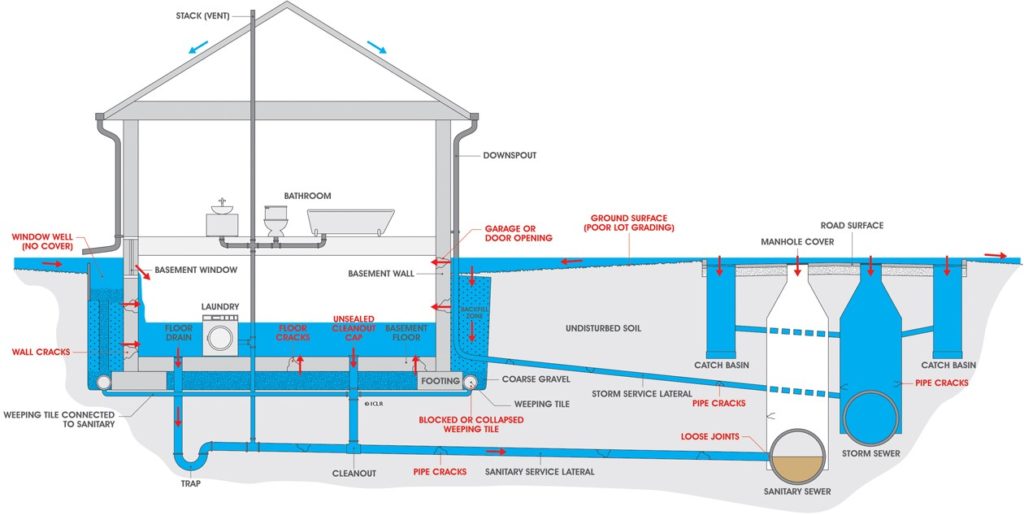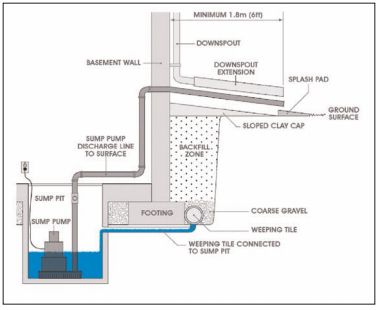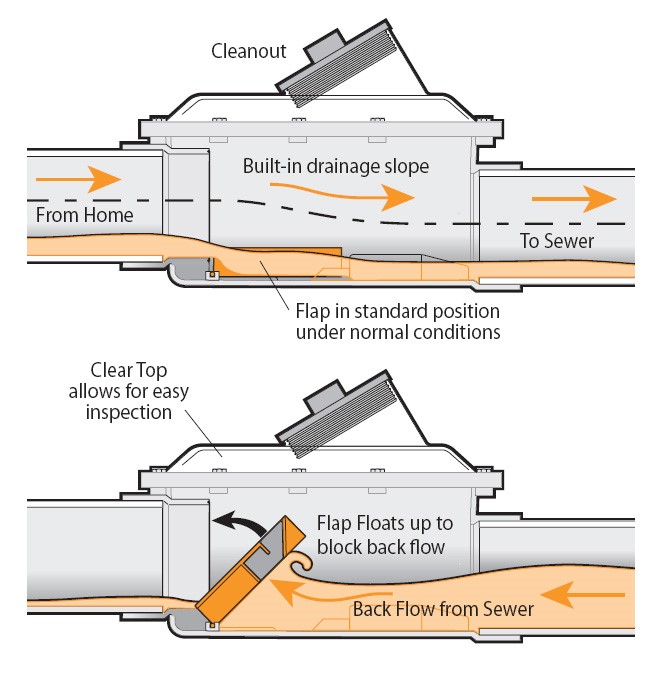Basement flooding can occur for many different reasons. The City of Sarnia tracks instances of basement flooding, and offers grants for homeowners to help mitigate some of the common causes of basement flooding.
Basement flooding report form
Report instances of basement flooding to the City.
Basement flooding grant program
Learn more about our Basement Flooding Grant Program assisting home owners in mitigating the causes of basement flooding.
Please continue reading for more information on the causes of basement flooding and ways to prevent it.
Common Causes of Basement Flooding
It is important to understand that basements are inherently prone to flooding. They are the lowest level of a building and are usually built partly or entirely below ground level. Due to this, there are many different reasons why a basement might flood. Principle among these is wall or foundation floor seepage from groundwater, from surface water sources, or by a sanitary or storm sewer backup.
Groundwater is water that is naturally located below the ground’s surface. During extended periods of wet weather, this groundwater level can rise above the level of the basement floor. In some locations the groundwater level is above the level of the floor at all times. When the groundwater level is above the level of the basement floor it tries to flow from high to low through gravity. This means that any cracks in the foundation floor or walls will provide an avenue for gravity to push water through (Figure 1).
Surface water flooding often becomes a factor during periods of heavy rain or snowmelt. In these situations water may pool around the house. This water then has the potential to flow into the home through the same methods of groundwater flooding or through other points of easy access like garage and basement doors (Figure 1).

Lastly, sewer backups are another major cause of basement flooding. By design, sanitary sewers always have a direct path into the home. Under normal conditions, this sanitary lateral allows water to flow from the house to the sewer. Since water flows by gravity through the sanitary lateral the sewer level is designed to be below the basement floor. It is possible for the water level in the sewer to rise above the basement floor which then allows for the sewer lateral to back up and push its contents into your basement. Sewers can also be backed up due to a partially or fully blocked sewer later (Figure 2). These blockages may be caused by pouring fats, oils, and grease down your kitchen drain. Learn more information on fats, oils, and grease disposal.

Resources
How to Prevent Basement Flooding
While there is no way to completely eliminate the risk of flooding, there are options to greatly reduce it.
Option #1: Installation of a sump pump system
Sump pumps are installed at the lowest point in the houses basement or crawlspace. Ground water migrates to the sump pump pit and is then pumped away from the foundation. This helps keep the ground water from infiltrating the basement and causing damage.
Keep in mind that sump pumps are designed to pump low volumes of water at a slow rate. They will not be able to pump water out of the basement fast enough to prevent damage if flooding is occurring.

Option #2: Installation of a backflow preventer
The purpose of a backflow preventer is to stop sewage from backing up from the sewer through the sanitary later and into the house. Flow is allowed to travel from the house to the sewer, but as soon as the flow switches direction from the sewer to the house the flap is pushed closed. This effectively stops the sanitary backup from occurring. It is important to note that when the sewer system is surcharged (flow attempting to travel from the sewer into the house) the backflow preventer also stops sewage from traveling from the house to the sewer. Caution is advised for water use during these conditions as the only storage place for this water is in the house’s internal plumbing.

Option #3: Sealing cracks and flaws in the houses foundation
Sealing cracks is a simple way to reduce the chances of infiltration flooding. Most of the time cracks can be sealed from inside the basement without the need for excavation.
Option #4: Insuring good lot grading
When houses are built there is also care taken to insure that the yard slopes away from the house. This helps keep water away from the foundation. Over time the yards can lose this slope as the soil settles, through landscaping, or new additions. To combat this yards can be regraded. See Figure 1 for a visual representation of poor lot grading.